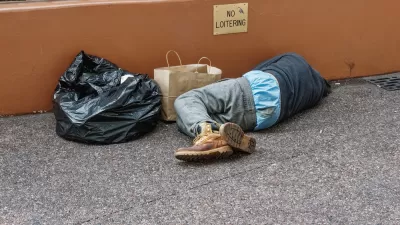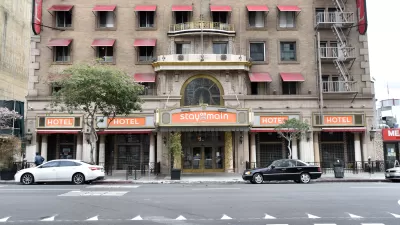There won't be many places left to sleep for the massive population of homeless living in the city of Los Angeles.

"A plan under consideration at City Hall would ban sleeping on streets and sidewalks within 500 feet of schools, parks, day-care facilities and some popular venues, eliminating at least a quarter of Los Angeles for homeless people trying to bed down at night," according to an L.A. Times feature by Matt Stiles, Ryan Menezes, and Emily Alpert Reyes.
The article includes an interactive map to illustrate the scope of the law, created by analysis performed by the L.A. Times team. In the whole city, there are 836 parks, 1,482 public and private schools, 1,161 day-care centers, nine special venues, and 43 homeless services that would be subject to a 500-foot buffer if the law is approved.
"Taken together, the buffers cover 124 square miles, about a quarter of the city," according to the article. "The estimate almost certainly understates the proposal's full potential."
The map allows analysis in the aggregate as well as at the neighborhood level. The article provides case studies in Venice, Hollywood, Koreatown, Downtown, Skid Row, and more.
If approved, the law would be the latest legal setback for the rights of the homeless to sleep on the streets. Los Angeles recently prohibited sleeping in cars, vans, and RVs, for instance.
FULL STORY: L.A. might ban homeless people from sleeping on many streets. What about your block?

Alabama: Trump Terminates Settlements for Black Communities Harmed By Raw Sewage
Trump deemed the landmark civil rights agreement “illegal DEI and environmental justice policy.”

Planetizen Federal Action Tracker
A weekly monitor of how Trump’s orders and actions are impacting planners and planning in America.

The 120 Year Old Tiny Home Villages That Sheltered San Francisco’s Earthquake Refugees
More than a century ago, San Francisco mobilized to house thousands of residents displaced by the 1906 earthquake. Could their strategy offer a model for the present?

In Both Crashes and Crime, Public Transportation is Far Safer than Driving
Contrary to popular assumptions, public transportation has far lower crash and crime rates than automobile travel. For safer communities, improve and encourage transit travel.

Report: Zoning Reforms Should Complement Nashville’s Ambitious Transit Plan
Without reform, restrictive zoning codes will limit the impact of the city’s planned transit expansion and could exclude some of the residents who depend on transit the most.

Judge Orders Release of Frozen IRA, IIJA Funding
The decision is a victory for environmental groups who charged that freezing funds for critical infrastructure and disaster response programs caused “real and irreparable harm” to communities.
Urban Design for Planners 1: Software Tools
This six-course series explores essential urban design concepts using open source software and equips planners with the tools they need to participate fully in the urban design process.
Planning for Universal Design
Learn the tools for implementing Universal Design in planning regulations.
Clanton & Associates, Inc.
Jessamine County Fiscal Court
Institute for Housing and Urban Development Studies (IHS)
City of Grandview
Harvard GSD Executive Education
Toledo-Lucas County Plan Commissions
Salt Lake City
NYU Wagner Graduate School of Public Service





























